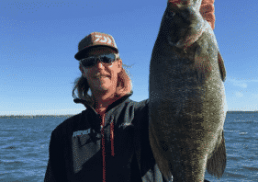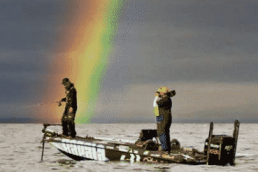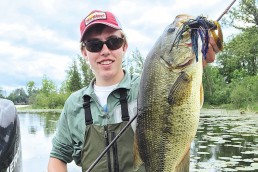Bassmaster AOY Champion Seth Feider Talks Mille Lacs Bass part two
SHARE THIS POST
In last month’s MWO, Bassmaster Elite Series angler and Minnesota native Seth Feider talked about the history of bass fishing on Lake Mille Lacs and his perspectives on the quality of the fishery. He also spoke on and how important it was to protect what’s considered by many to be the “best smallmouth lake in the country.” Here, we continue his story as Feider shares details further on how to catch these prized fish.
MidWest Outdoors: An early catch-and-release season for smallmouth bass opens in Minnesota on May 13. The bass season fully opens on May 27. Tell our readers how to locate the fish on a lake as big as Mille Lacs.
Seth Feider: Compared to summer and fall, spring is different. Most of the year, those fish congregate on just a few major pieces of structure. You may need to hunt for them for a while, but when you find them, it’s the mother lode. In spring, it’s the exact opposite—bass are literally on every piece of shallow rock structure in the whole lake so they are easy to find. They’re on every shoreline and little reef or point that comes out from shore, even the offshore reefs. Spring is a good time to fish the lake if you’re unfamiliar with it because you can’t go more than 50 yards without catching a bass. It’s also the best time—other than October—to catch the biggest bass, as those pre-spawn females are giants.
MWO: The early catch-and-release season mandates that these fish be returned to the water. Starting with the May 27 bass opener, all bass 17-21 inches must be released, but anglers can keep three bass, one of which can exceed 21 inches. How important is it for anglers to protect the Lake Mille Lacs bass fishery, even after the May 27 opener when anglers can keep some fish?
Feider: I’ve talked about this—it’s huge, critical. Catch-and-release fishing for smallmouths for the past 20-plus years has made this lake what it is today. It’s the best smallmouth lake in the country because we’ve been releasing those fish for all these years. It’s not like down South where the bass grow fast in warm water. In these cold northern lakes, a 5-pound smallmouth is 15 to 20 years old. I don’t personally keep bass, but if people want to keep smaller ones for a meal, that’s their choice.
MWO: Readers who live outside of Minnesota may not be familiar with the unique, varied structure of Lake Mille Lacs. Narrow down the water for bass anglers.
Are you enjoying this post?
You can be among the first to get the latest info on where to go, what to use and how to use it!
Feider: In May and June the bass are definitely using the shallower parts of the reefs. Points that jut out from shore, all the rock humps, either connected to shore or near the shorelines, plus the offshore reefs that top out in shallow water, are all prime spots for spring smallmouths. You can eliminate all of the mud basin and most of the main-lake weedlines and sand. I concentrate all my efforts in 10 feet of water or less, and you definitely want to be around rocks. If it’s got rock on it, it has bass. On Mille Lacs, that means you’ll be fishing from the bank to a mile out, or less. And don’t forget the bays in spring—a lot of fish load into Isle Bay, Cove Bay, Wahkon and Vineland bays, plus fish always are around Garrison and Myr Mar too. As windy and as rough as it can get, it’s nice to have the bays as a backup plan. For pre-spawn fish in May, you can never go wrong with a jerkbait. My number one presentation would be a Rapala Shadow Rap; choose some of the more natural minnow patterns. A couple of my favorites are Bone and Bud. I throw jerkbaits on a Daiwa Tatula 6-foot 9-inch, medium-light baitcasting rod paired with the SV reel spooled with 10-pound-test Sufix Castable Fluorocarbon.
MWO: How about post-spawn fish? How do you like to target them?
Feider: Right after the spawn, a Skitter Pop or Chug Bug is a great way to catch them. I use the same rod and reel combo for topwaters as I do for jerkbaits, just with different line on the reel. The 30-pound-test Sufix 832 Braid in Moss Green is the way to go with a 14-pound Sufix ProMix monofilament leader. Topwaters are perfect for these shallow spots where you find the bass, and they can be good into early July. The fish just don’t leave the shallow areas because they have no place else to go.
MWO: The structural transitions on Lake Mille Lacs are well defined. Where the nearshore reefs end, the mud basin begins, so the fish don’t roam all over the lake.
Feider: That’s right—they move up and down the structure, changing depth, but stay close to rocks all year. They have all the minnows, crayfish and bugs they need to eat. My absolute favorite time of year—with the exception of late fall in October—is typically when we have our first mayfly hatch of the year. It usually starts happening mid-June, right after most of the fish are coming off their beds. When the bug hatches start, the hair-jig fishing is second to none. I use a Daiwa Tatula Elite medium-light rod with 6-pound Sufix 832 Hi-Vis Green with an 8-pound-test Sufix fluorocarbon leader spooled on a Daiwa Luvias 3012 reel. I throw marabou jigs in brown, in a lighter weight at 1/16 to 1/8 ounce. It’s easy fishing: cast it out and slow-wind it in. It’s not a bottom-contact deal, but more like a gliding, slow-roll retrieve, about halfway down in the water column.
MWO: What’s your personal best Lake Mille Lacs smallmouth?
Feider: I boated a 7-pound, 2-ouncer two falls ago. And last year I got another one just as big, without a scale in the boat. Not like a state record or anything—but giants! If folks coming up to Mille Lacs catch some of those big ones they can always let ‘em go and get a graphite replica made. Those reproductions look much better and last way longer than a skin mount anyway. Release them and let someone else catch them again. Some of those fish are nearly 20 years old. Just imagine how many times some of those big 5- to 6-pound fish have been caught in Mille Lacs—it’s what makes it such a world-class fishery.
MWO
SHARE THIS POST
Did you enjoy this post?
You can be among the first to get the latest info on where to go, what to use and how to use it!
MWO
We believe being outdoors is good. With more than 1,000 articles each year, MidWest Outdoors magazine is all about sharing outdoor experiences with you—where to go, what to use and how to use it… whether you’re close to home or on that trip of a lifetime.


